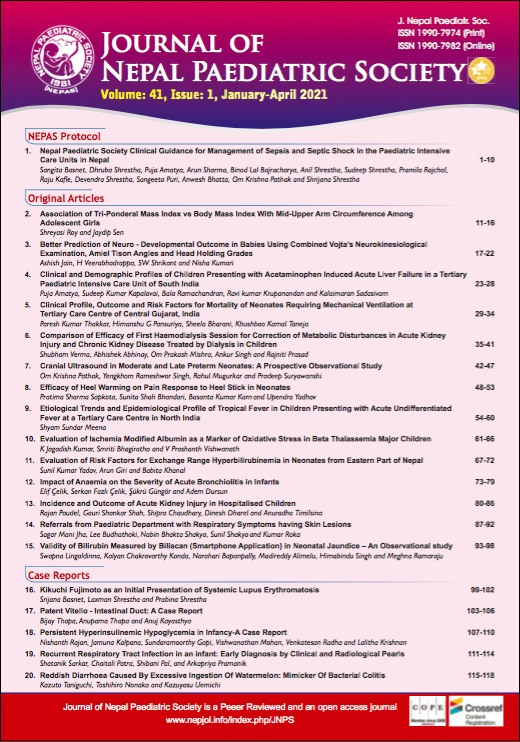Association of Tri-Ponderal Mass Index vs Body Mass Index With Mid-Upper Arm Circumference Among Adolescent Girls
DOI:
https://doi.org/10.3126/jnps.v41i1.29573Keywords:
Adolescent girls, BMI, MUAC, Tri-ponderalAbstract
Introduction: Since 2017, number of studies involving nutritional status of adolescents using a novel parameter named tri-ponderal mass index (TMI) is soaring high. The concept of TMI was formulated to substitute body mass index (BMI) in case of adolescent population. The present study aims to find TMI values of school-going adolescent girls (aged 10 to 19 years). It also aims to compare the association of TMI and BMI with mid-upper arm circumference (MUAC) of the subjects.
Methods: Height, weight and MUAC were measured using standard procedures. The BMI and TMI were accordingly calculated. The data obtained was tabulated to elucidate age-wise descriptive statistics. Quadratic polynomial regression was employed to yield a general conclusion regarding association of TMI and BMI with MUAC of the subjects. Receiver operating characteristic (ROC) curve was plotted to check which of the two indices, BMI or TMI, has better ability to predict higher MUAC of the subjects.
Results: The ROC-area under curve (AUC) was 0.867 and 0.955 for TMI and BMI respectively.
Conclusion: BMI has better association with MUAC. In comparison to TMI, BMI has superior ability in predicting higher MUAC of the subjects.
Downloads
Downloads
Published
How to Cite
Issue
Section
License
Authors who publish with this journal agree to the following terms:
Authors retain copyright and grant the journal right of first publication with the work simultaneously licensed under a Creative Commons Attribution License that allows others to share the work with an acknowledgement of the work's authorship and initial publication in this journal.
Authors are able to enter into separate, additional contractual arrangements for the non-exclusive distribution of the journal's published version of the work (e.g., post it to an institutional repository or publish it in a book), with an acknowledgement of its initial publication in this journal.
Authors are permitted and encouraged to post their work online (e.g., in institutional repositories or on their website) prior to and during the submission process, as it can lead to productive exchanges, as well as earlier and greater citation of published work (See The Effect of Open Access).



